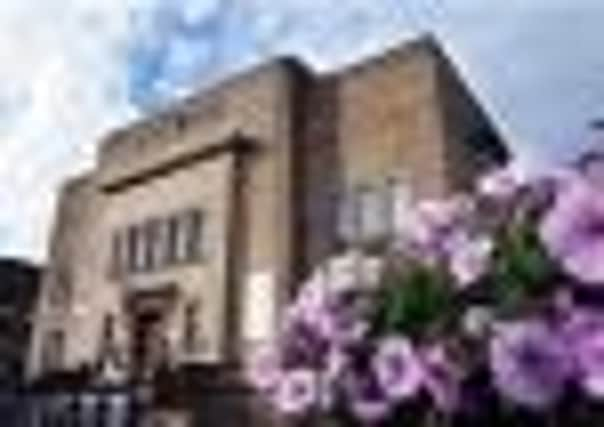Profile on...


As West Yorkshire mill towns go, Huddersfield was a late developer. On the eve of the Industrial Revolution, one visitor described it as “a miserable village” and the earliest map of the town from 1716 shows little more than a cluster of houses.
But there are advantages to being a late-developer, and when the nineteenth-century burghers of Huddersfield finally got round to expressing their commercial and civic ambitions in stone they had plenty of space and they weren’t afraid to use it.
Advertisement
Hide AdAdvertisement
Hide AdMuch of what they built still exists. There are the grand warehouses close to the station – itself a Grade I listed building and, according to John Betjeman “the most splendid station façade in England”.


There are the spacious streets which once boasted the first municipal transport service in Britain – a system of steam trams. There are suitably glorious places of worship, including the Queen’s Street Methodist Mission (now the thriving Lawrence Batley Theatre).
And of course there is the recently refurbished Town Hall with its magnificent concert hall.
Huddersfield’s architectural confidence extended well into the 20th century with significant new buildings – the library and the Co-op extension being added in the 1930s.
Advertisement
Hide AdAdvertisement
Hide AdBut perhaps the most exciting addition to Huddersfield’s recent architecture is a bit of a secret.


The unique cast concrete ceiling of Queensgate market is simply a wonderful surprise. It was listed in 2008, but the problem remains of how it will be used in the future.
Putting past glories to one side, however, there is no doubt that early 21st century Huddersfield is suffering. High Street chain stores occupying key sites have closed, and the shops remain boarded up.
Even the shiny new Kingsgate shopping centre is far from full. In the meantime, like other medium-sized Yorkshire towns, Huddersfield seems to have a lot of phone shops, bars and estate agents.
Advertisement
Hide AdAdvertisement
Hide AdThe council’s recent response to Huddersfield’s spaciousness seems to be to create yet another “centre” to the Pack Horse shopping centre, The Piazza, The Kingsgate centre? Add in a couple of (slightly) out of town shopping centres, an outsize Sainsbury’s and a (soon to be outsize) Tesco and you have a recipe for shoppers wandering from one “centre” to another.
But it’s worth persevering and some of the best is to be found on the edges. Some of Huddersfield’s old established businesses continue to flourish just off the main thoroughfares – H Mitchell’s for example, one of the best butchers in West Yorkshire, can be found on Station Street. And no visit to Huddersfield is complete without joining the group of people marveling at Walkers Jewellers’ window display on Market Walk.
More contemporary pleasures are to be found in the Byram Arcade, a pretty 19th-century arcade housing a whole range of independent businesses. You can buy innovative fashion at The Left Bank (which designs and makes its own clothes), or make your own after a visit to Spun (which sells wool, fabric and holds regular workshops). Calder Graphics supplies materials to Huddersfield’s arty types, or why not become a walking work of art at The Bleeding Art tattooing and piercing studio?
Leaving the town centre, the prosperous and pretty suburb of Lindley is also worth a visit. Its unique Art Nouveau clock tower is a striking addition to Huddersfield’s architecture. But the best thing about Lindley is its distinctive village feel. The welcoming High Street has a host of cafes, delis, boutiques, three butchers and the best children’s bookshop in south-west Yorkshire.
Advertisement
Hide AdAdvertisement
Hide AdWhen they don’t have their nose in a book, the children of Lindley have the opportunity of continuing one of their town’s finest traditions, choral singing. Lindley Junior School Choir is one of the best children’s choirs in the country, but it is only one of a number of exceptional Huddersfield choirs, which include of course, the world famous Choral Society.
There are also some interesting newcomers such as the acapella singing group Wildnotes, who perform traditional music from across the world, and the award winning Huddersfield Young Singers, a choir of over a hundred young people inspired by the Gospel tradition.
Despite difficult times, music and culture in Huddersfield continue to thrive, and perhaps the best time to visit is during one of the town’s several major festivals, which include Huddersfield Contemporary Music Festival, the Huddersfield Carnival, and the winter Festival of Light, a feast of street theatre, live performances and installations which takes place in early December.
HUDDERSFIELD AND LINDLEY: THE FACTS
* Huddersfield became known as “the town that bought itself” after Huddersfield Corporation bought the manor of Huddersfield off its absentee landlords, the Ramsdens, in 1920.
Advertisement
Hide AdAdvertisement
Hide Ad* The town was the centre of Luddite activity. The Lawrence Batley Theatre has just been awarded a large grant from the Heritage Lottery Fund to celebrate the two-hundredth anniversary of the Luddite uprising next year.
* Lindley topped a 2006 survey by RBS which aimed to find the best location for a first-time buyer to get on the property ladder.
* In earlier times, Huddersfield’s Castle Hill was known as “Wormcliffe” because a dragon or “Wyrm” was believed to guard a hoard of treasure there.